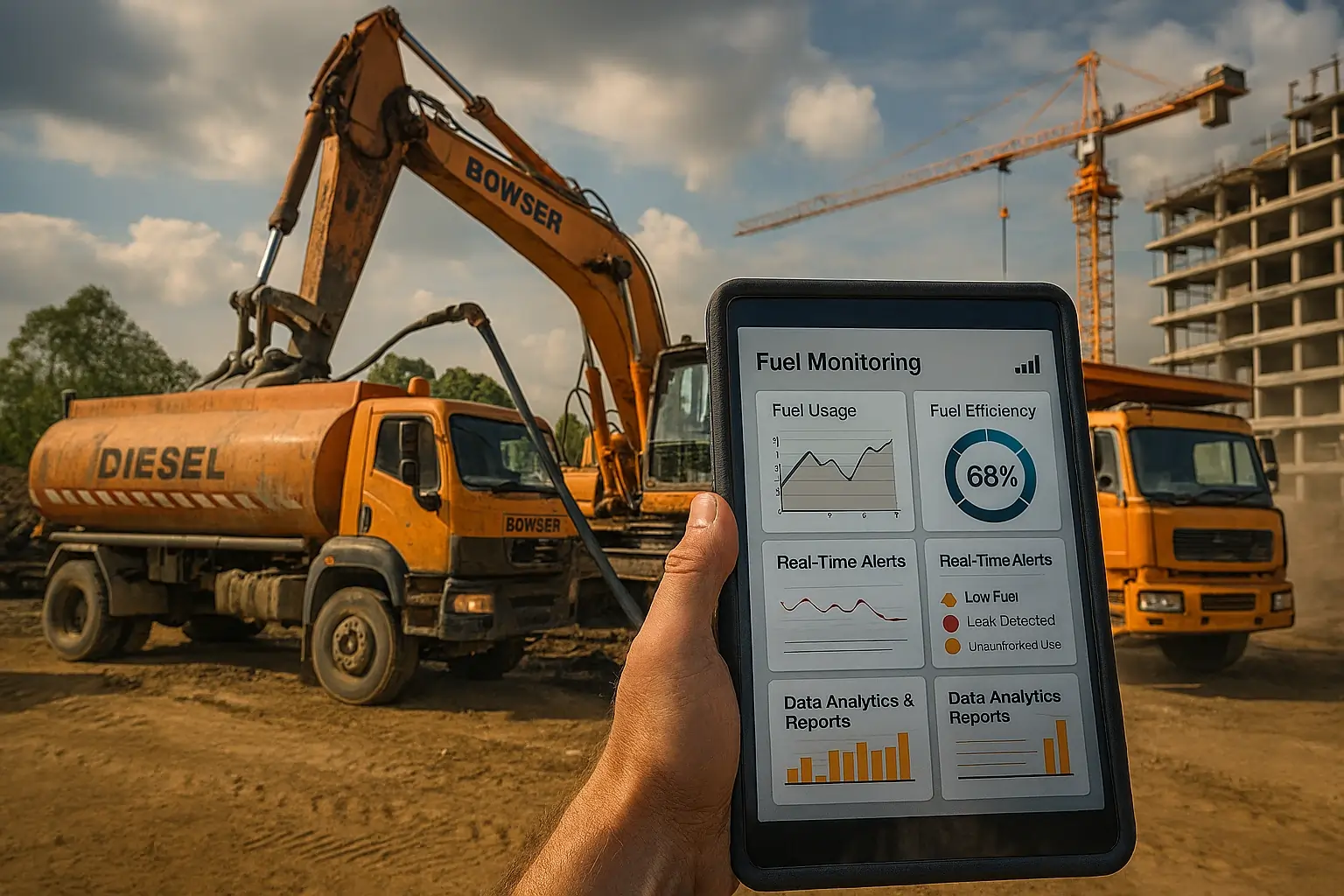 Blog
Blog2025-July-18
Fuel Monitoring System in Construction: Real-Time Diesel Tracking and Control
In large-scale construction and infrastructure projects, fuel is the pulse that keeps every machine alive. Excavators, dumpers, batching plants, and generators — all depend on a steady, accountable flow of diesel. But without control, fuel quickly becomes one of the most mismanaged and costly resources on site.
A Fuel Monitoring System changes that. It replaces manual logs and assumptions with real-time data, allowing companies to see exactly how fuel is received, stored, and consumed. With IoT sensors, flow meters, and cloud dashboards, it helps project teams eliminate fuel theft, reduce wastage, and build complete trust in their fuel operations.
What is a Fuel Monitoring System?
A Fuel Monitoring System is an advanced IoT-based solution that continuously tracks fuel levels, dispensing, and consumption across construction sites. It eliminates manual readings and guesswork by delivering real-time, verifiable data — helping companies achieve complete transparency and control over every liter of diesel used.
Core Components:
Smart fuel-level sensors – Monitor tanks and machinery with real-time accuracy.
High-precision flow meters – Measure each dispensing activity to the exact liter.
IoT devices – Transmit live fuel data securely to a centralized platform.
GPS trackers – Track bowsers and fuel tankers to ensure verified movement.
Cloud dashboards – Give instant visibility to site and HQ teams.
Automated alerts – Detect theft, leaks, or unusual fuel patterns instantly.
Together, these technologies create a connected, intelligent fuel ecosystem where movement is transparent, usage is measurable, and every drop of fuel is fully accountable.
Why Every Construction Company Needs a Fuel Monitoring System
Fuel is the second-largest variable expense in infrastructure projects, yet it’s often tracked using outdated methods like dipsticks and handwritten logs. This leads to inaccuracies, theft, and unnecessary costs.
Without a Fuel Monitoring System, companies risk:
- Theft during storage or refueling
- Manual log errors and false reporting
- Unauthorized fueling of subcontractor vehicles
- Overbilling from vendors or fuel suppliers
- Idle fuel burn due to poor equipment management
- Limited visibility in remote project locations
By digitizing fuel management with a Fuel Monitoring System, construction firms can transform these weak points into strengths — saving up to 30% in fuel costs while improving operational transparency.
How a Fuel Monitoring System Works
A Fuel Monitoring System works like a digital watchdog for your fuel — tracking every movement from delivery to consumption with precision and speed. It integrates effortlessly into daily construction workflows, ensuring real-time visibility and control.
Here’s how it keeps operations transparent and accountable:
- Smart sensors track tank levels and instantly detect refills or leaks
- Flow meters measure each liter dispensed, preventing overuse or tampering
- Operator authentication ensures fueling is done only by authorized staff
- Machine consumption data links directly to engine working hours
- GPS tracking monitors bowser routes and refueling points
- Cloud dashboards provide live site-to-HQ visibility in one place
- Automated alerts highlight unusual fuel activity instantly
In short, a Fuel Monitoring System builds a closed, intelligent fuel loop — where every drop is tracked, every action verified, and nothing goes unnoticed.
Key Benefits of a Fuel Monitoring System
A Fuel Monitoring System does more than monitor fuel — it transforms how construction sites manage, track, and save it. By converting every liter into measurable data, it brings control, accuracy, and efficiency to daily operations.
Key advantages include:
- Prevents diesel theft and misuse with instant alerts and real-time tracking
- Reduces wastage and idle burn through data-driven insights
- Verifies every fuel delivery and transaction with complete transparency
- Eliminates manual logs and human errors through automated reporting
- Ensures audit-ready fuel records for accountability and compliance
- Improves machine productivity with live fuel-to-hour analytics
- Enables smart, data-backed decisions for management and cost control
By implementing a Fuel Monitoring System, companies turn fuel from a recurring expense into a strategic asset — reducing costs, improving efficiency, and achieving true operational visibility.
Future of Fuel Monitoring Systems
The future of the Fuel Monitoring System lies in intelligence and automation. With the integration of AI, analytics, and cloud technology, it’s evolving from simple tracking to predictive control. Modern systems will not only track fuel but also forecast usage patterns, detect inefficiencies, and optimize refueling schedules automatically.
As construction becomes more digital, the Fuel Monitoring System will play a central role in building smarter and more sustainable operations. By connecting with ERP and telematics platforms, it will unify data across all fuel activities — ensuring transparency, efficiency, and complete operational control.
Frequently Asked Questions
1. Can a Fuel Monitoring System eliminate diesel theft completely?
It significantly minimizes theft by enabling real-time visibility and automated alerts.
2. Is it suitable for both stationary tanks and mobile bowsers?
Yes, a Fuel Monitoring System can monitor both fixed and mobile assets seamlessly.
3. How quickly can a company see results?
Most sites report measurable savings and control within 30 to 60 days.
4. Does it work in remote or highway projects?
Yes. With satellite or 4G/5G connectivity, monitoring continues uninterrupted.
5. Can it integrate with existing telematics or ERP systems?
Yes, it supports data exchange via APIs for unified management dashboards.
